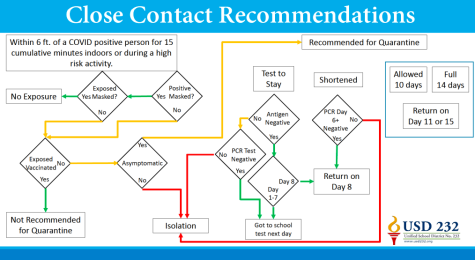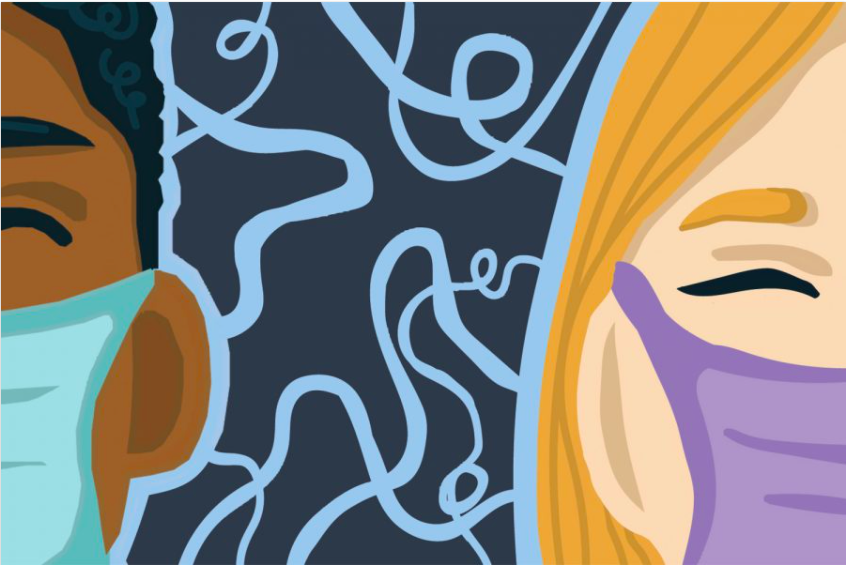What is Test to Stay and Learn? FAQs with assistant superintendent Alvie Cater
With the district approving the implementation of the program Test to Stay and Learn, Cater explains the program and what it could mean for the district
Assistant superintendent Alvie Cater sits down with Mill Valley News editors Gabby Delpleash and Avery Gathright to discuss the district’s upcoming implementation of the “Test to Stay” program; a program created to keep students in school for as long as possible who have suffered an exposure to the COVID-19 virus
October 13, 2021
Mill Valley News: Now that the school board has voted to implement this program, what is the Test to Stay and Learn?
Assistant superintendent Alvie Cater: It’s a series of testing strategies that is available to any school district in the state of Kansas. It is being offered through federal funding that was awarded to the Kansas Department of Health and Environment (KDHE). Federal funds are actually being targeted for school districts to increase COVID-19 testing in basically pre-K through 12. KDHE is administering the grant, and to provide these testing strategies.
MVN: What is the goal of the program?
AC: The whole goal is to provide opportunities to keep students in school, as long as possible. Test to Stay and Learn is a plan that would provide free daily testing for students and staff who are identified as a close contact by the county health department. [Being a] close contact means that you have been identified as being a close contact to someone who has tested positive for COVID-19. If a student is identified as a close contact, they would be recommended for quarantine [by the county health department], and then what the school district does at that time is exclude the student for recommended quarantine. With this Test to Stay and Learn plan, we could provide the parent or guardian the option, it’s voluntary, that they could test each day for a series of days. As long as they continue to test negative, they can go to school that day and participate in activities.
MVN: How long would testing be necessary for close contacts?
AC: The maximum number of days that someone would need to test would be seven. And so long as you stay negative and you’re symptom-free, then you can continue to go about your activities. If someone does develop symptoms, and they test negative, then we would work with the county health department to make sure that that student can find a way to stay, because sometimes symptoms [could be caused by something besides COVID-19]. So that’s how that would work, it would be for seven days maximum, but it’s based on the date if the last exposure.

MVN: Where will students be tested?
AC: What we’re thinking about doing is a Test to Stay curbside option, and Cedar Trails Exploration Center is centrally located, and what we’re looking to do is offer a Test to Stay [Covid-19 test] before school even starts. A student could go to [CTEC] first thing in the morning, drive through, do the swab, and then wait for 15 minutes in the car, and then find out, ‘Hey, can I continue on with my day?’
MVN: How will this affect the district financially?
AC: It’s not going to affect us at all, because this is a grant, the district would be reimbursed for any expenses. Really, the only expenses would be any staffing that we would need. We would be reimbursed from KDHE for that expense. There are also a few dollars that could be used for personal protective equipment like gloves, masks [and] things that would be needed to support the testing program but the biggest portion of the grant would be for staffing. That’s what we would utilize those funds for. This is a reimbursement program so we don’t get the money upfront, so we would have to submit reimbursement back to the state.
MVN: How soon will the program be implemented?
AC: One of the reasons why we’re looking at doing, at least initially, the curbside option before school starts, is that we can use our existing nurses, so they could actually do it before school starts, and not impact their duties during the school day. We would pay those nurses I think anywhere from an hour and a half to two hours of additional time. And so that’s how we would do it and then that gives us time to add any additional staff so that we could continue to do that option before school and maybe even start taking some of that into the buildings. But in order to get started, we decided that we’d like to do it with our existing nurses who have volunteered to help us. That way, we can start just as soon as we can get all the details and logistics worked out so I’m just hoping in a few days.
MVN: How can we be sure the program will be successful?
AC: KDHE has worked very hard to establish protocols to ensure that the Test to Stay strategy goes as smoothly as possible. We also know with a program that we’ve never done before, it’s going [to be a] learn as you go [process for the district.] But the systems that we’ve seen look to be very well done, meaning that we can stay on top of the information that’s required to have. [That way,] we make sure that when we test someone, that that is associated to that person and only that person, and we make sure that we can repeat this on a daily basis. I think we’re going to be working very hard to meet all the requirements that the state has for us, but also at the same time make sure that it is as smooth as possible for our students and parents.
MVN: Is there anything you would like to clarify?
AC: The school district doesn’t have the authority to tell [a student they] have to quarantine. Only the county health department can issue that kind of order. School districts in Kansas do have the authority to exclude students, when it is related to communicable diseases. That’s been a question that parents have asked, going back to the last school year, how can a school district exclude somebody for a recommended quarantine? That’s part of state statute that we do that; so we don’t have the power to issue quarantines to students but we can exclude students for a recommended quarantine. The last thing I would say is that we know that this testing option is not going to be for everyone, and we’ll have some families who do not want to participate, and that’s fine. What I’m trying to do in my role is to look at [how] this might be an option for some of our families, that would result in keeping students in school longer than we previously would have been able to do so.











